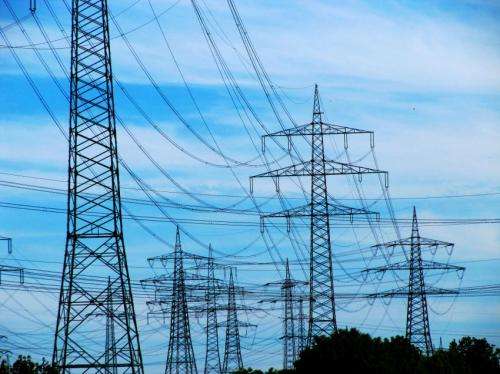Electricity grids: The energy turnaround requires new technologies for a reliable supply. Credit: Photo: Rainer Sturm/pixelio.de
Getting the grid prepared for the increased use of renewable energy sources is the goal of the Helmholtz Energy Alliance "Technologies for the Future Power Grid" coordinated by KIT. Helmholtz researchers are developing solutions for a flexible and reliable grid which manages the fluctuating power supply from renewable energy sources in cooperation with university partners and utilities.
Another focus of the research activities is the interconnection of the electric power grid with the existing gas distribution network in order to use gas distribution networks as energy storages. The Helmholtz Association will subsidise the Energy Alliance with 3.2 million Euros from its Initiative and Networking Fund in 2013 and 2014.
The energy turnaround and the therefore increased use of renewable energy sources requires a conversion of the power grid. Due to the increased electric power generated by wind and photovoltaic power plants and the emerging electric mobility, it is foreseeable that today's power grid will not be able to meet future requirements.
"The expansion and alteration of the grid is of very high importance if one wants to ensure reliable and affordable future energy supplies," explains Professor Thomas Leibfried, head of KIT's Institute of Electric Energy Systems and High-Voltage Technology (Institut für Elektroenergiesysteme und Hochspannungstechnik – IEH). Together with Professor Mathias Noe, head of KIT's Institute for Technical Physics, Leibfried acts as scientific spokesperson of the alliance. "Such alteration," Leibfried says "is not only important from the point of view of Germany but also from the European perspective: Since today's 400 kV grid is being operated throughout Europe, issues of grid stability cannot be solved in purely regional or purely national contexts."
Institutes of the Technische Universität Darmstadt, Technische Universität Dortmund, and RWTH Aachen complete the skills and capabilities contributed by KIT as partners in the alliance. Forschungszentrum Jülich and the utilities EnBW Energie Baden-Württemberg AG, MAINOVA AG, and Stadtwerke Karlsruhe Netze GmbH act as associated partners.
Next to the development and the comparative evaluation of different technologies, the Helmholtz Energy Alliance also wants to promote urgently needed young scientists and, in particular, intends to increase the percentage of women among the PhD students financed by Helmholtz. Therefore, the partners will establish a joint PhD program.
Key Topics
The Energy Alliance deals with four key topics: While "system management within the distribution grid" covers the intelligent control of the distribution grid in view of the increasing supply from decentralized and fluctuating energy sources, "system management and stability of a hybrid transmission grid" investigates the structure and operation of a HVDC supergrid superimposed to the existing HVAC network. New technologies will be required to implement and manage the so far not existing HVDC grids. The latter topic, in addition, deals with the development of suitable equipment based on novel technologies, e.g., high temperature superconductivity. A further aspect is the development of innovative methods and technologies which ensure grid stability. As, due to the decrease of conventional power plants, the number of rotating masses of turbines and synchronous generators - which today provide the so-called instantaneous reserve that balances the difference between generated and consumed power - also decreases.
The topic "integration of storage systems into the future power grid" focuses on the interconnection of the electric power grid and the gas distribution network using the latter for storing that amount of electrical power, generated e.g. by wind power plants, which is not instantaneously consumed. Last, but not least, the Energy Alliance deals with "comparative technology evaluation" based on different criteria such as economic efficiency and contribution to the energy turnaround.
Provided by Helmholtz Association of German Research Centres





















